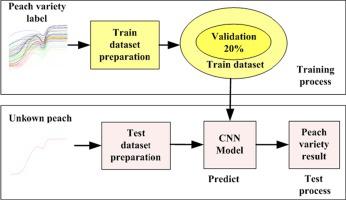当前位置:
X-MOL 学术
›
Comput. Electron. Agric.
›
论文详情
Our official English website, www.x-mol.net, welcomes your feedback! (Note: you will need to create a separate account there.)
Peach variety detection using VIS-NIR spectroscopy and deep learning
Computers and Electronics in Agriculture ( IF 8.3 ) Pub Date : 2020-08-01 , DOI: 10.1016/j.compag.2020.105553 Dian Rong , Haiyan Wang , Yibin Ying , Zhengyong Zhang , Yinsheng Zhang
Computers and Electronics in Agriculture ( IF 8.3 ) Pub Date : 2020-08-01 , DOI: 10.1016/j.compag.2020.105553 Dian Rong , Haiyan Wang , Yibin Ying , Zhengyong Zhang , Yinsheng Zhang

|
Abstract More than 1000 peach varieties with significant differences in qualities are cultivated in China. Distinguishing peach varieties is not only needed by peach dealers, but also demanded by products processing enterprises and consumers. Detecting the varieties of fruit is one of the most important analyses. Over the past decades, there are many linear or nonlinear methods have been proposed, such as principal component analysis, partial least squares, support vector machine etc. However, these traditional methods commonly need some preprocessing steps including denoising, baseline correction, wavelength selection and so on. Hence, it requires the users to have enough skilled knowledge before they can establish a good performance detection model. To offer information on identifying peach varieties, visual near-infrared (VIS-NIR) diffuse reflectance spectra between 350 and 820 nm were collected for five peach varieties, 100 samples for each variety, the total samples consisted of 500 peaches. Spectral information has shown the rapid non-destructive measurement ability in many research fields. In recent years, the spectral information was researched for detecting the sugar and firmness of fruits, for examples, apple, peach, tomato and so on. Some traditional detection methods using spectra require application specific transforms, expertly designed constraints and model parameters, and have limited detection performance due to their maintenance costs. With the development of machine learning technology in recent years, deep learning which plays an important role in different research projects has won the eyes of fields from both academy and industry. In order to classify peach varieties by analyzing VIS-NIR spectra, a detection method based on deep learning principle is proposed in this paper. In this paper, the method can realize multi-identification peach varieties, by constructing a one dimensional convolution neural network and establishing a VIS-NIR spectra database containing five kinds of peaches. The network model is obtained through training, and then is employed to predict the testing set data. The accuracy of models based on deep learning reached 100% in the validation dataset and 94.4% in the test dataset. This study indicated that peach varieties could be distinguished successfully by using VIS-NIR spectroscopy and deep learning.
中文翻译:

使用 VIS-NIR 光谱和深度学习进行桃品种检测
摘要 我国栽培有1000多个品质差异显着的桃品种。区分桃品种不仅是桃经销商的需要,也是产品加工企业和消费者的要求。检测水果品种是最重要的分析之一。在过去的几十年里,已经提出了许多线性或非线性方法,如主成分分析、偏最小二乘法、支持向量机等。 然而,这些传统方法通常需要一些预处理步骤,包括去噪、基线校正、波长选择和很快。因此,需要用户具备足够的技术知识,才能建立良好的性能检测模型。提供有关识别桃品种的信息,收集了 5 个桃品种的 350 和 820 nm 之间的可见近红外 (VIS-NIR) 漫反射光谱,每个品种 100 个样品,总样品由 500 个桃组成。光谱信息在许多研究领域都显示出快速无损测量的能力。近年来,光谱信息被研究用于检测水果的糖度和硬度,例如苹果、桃子、番茄等。一些使用光谱的传统检测方法需要应用特定的变换、专业设计的约束和模型参数,并且由于维护成本而具有有限的检测性能。近年来随着机器学习技术的发展,深度学习在不同的研究项目中发挥着重要作用,赢得了学术界和工业界的关注。为了通过分析可见光-近红外光谱对桃品种进行分类,本文提出了一种基于深度学习原理的检测方法。本文通过构建一维卷积神经网络,建立包含五种桃子的VIS-NIR光谱数据库,实现桃子品种的多识别。通过训练得到网络模型,然后用于预测测试集数据。基于深度学习的模型在验证数据集中达到 100%,在测试数据集中达到 94.4%。本研究表明,利用 VIS-NIR 光谱和深度学习可以成功区分桃品种。为了通过分析可见光-近红外光谱对桃品种进行分类,本文提出了一种基于深度学习原理的检测方法。本文通过构建一维卷积神经网络,建立包含五种桃子的VIS-NIR光谱数据库,实现桃子品种的多识别。通过训练得到网络模型,然后用于预测测试集数据。基于深度学习的模型在验证数据集中达到 100%,在测试数据集中达到 94.4%。本研究表明,利用 VIS-NIR 光谱和深度学习可以成功区分桃品种。为了通过分析可见光-近红外光谱对桃品种进行分类,本文提出了一种基于深度学习原理的检测方法。本文通过构建一维卷积神经网络,建立包含五种桃子的VIS-NIR光谱数据库,实现桃子品种的多识别。通过训练得到网络模型,然后用于预测测试集数据。基于深度学习的模型在验证数据集中达到 100%,在测试数据集中达到 94.4%。本研究表明,利用 VIS-NIR 光谱和深度学习可以成功区分桃品种。该方法通过构建一维卷积神经网络,建立包含五种桃子的VIS-NIR光谱数据库,可以实现桃子品种的多识别。通过训练得到网络模型,然后用于预测测试集数据。基于深度学习的模型在验证数据集中达到 100%,在测试数据集中达到 94.4%。本研究表明,利用 VIS-NIR 光谱和深度学习可以成功区分桃品种。该方法通过构建一维卷积神经网络,建立包含五种桃子的VIS-NIR光谱数据库,可以实现桃子品种的多识别。通过训练得到网络模型,然后用于预测测试集数据。基于深度学习的模型在验证数据集中达到 100%,在测试数据集中达到 94.4%。本研究表明,利用 VIS-NIR 光谱和深度学习可以成功区分桃品种。基于深度学习的模型在验证数据集中达到 100%,在测试数据集中达到 94.4%。本研究表明,利用 VIS-NIR 光谱和深度学习可以成功区分桃品种。基于深度学习的模型在验证数据集中达到 100%,在测试数据集中达到 94.4%。本研究表明,利用 VIS-NIR 光谱和深度学习可以成功区分桃品种。
更新日期:2020-08-01
中文翻译:

使用 VIS-NIR 光谱和深度学习进行桃品种检测
摘要 我国栽培有1000多个品质差异显着的桃品种。区分桃品种不仅是桃经销商的需要,也是产品加工企业和消费者的要求。检测水果品种是最重要的分析之一。在过去的几十年里,已经提出了许多线性或非线性方法,如主成分分析、偏最小二乘法、支持向量机等。 然而,这些传统方法通常需要一些预处理步骤,包括去噪、基线校正、波长选择和很快。因此,需要用户具备足够的技术知识,才能建立良好的性能检测模型。提供有关识别桃品种的信息,收集了 5 个桃品种的 350 和 820 nm 之间的可见近红外 (VIS-NIR) 漫反射光谱,每个品种 100 个样品,总样品由 500 个桃组成。光谱信息在许多研究领域都显示出快速无损测量的能力。近年来,光谱信息被研究用于检测水果的糖度和硬度,例如苹果、桃子、番茄等。一些使用光谱的传统检测方法需要应用特定的变换、专业设计的约束和模型参数,并且由于维护成本而具有有限的检测性能。近年来随着机器学习技术的发展,深度学习在不同的研究项目中发挥着重要作用,赢得了学术界和工业界的关注。为了通过分析可见光-近红外光谱对桃品种进行分类,本文提出了一种基于深度学习原理的检测方法。本文通过构建一维卷积神经网络,建立包含五种桃子的VIS-NIR光谱数据库,实现桃子品种的多识别。通过训练得到网络模型,然后用于预测测试集数据。基于深度学习的模型在验证数据集中达到 100%,在测试数据集中达到 94.4%。本研究表明,利用 VIS-NIR 光谱和深度学习可以成功区分桃品种。为了通过分析可见光-近红外光谱对桃品种进行分类,本文提出了一种基于深度学习原理的检测方法。本文通过构建一维卷积神经网络,建立包含五种桃子的VIS-NIR光谱数据库,实现桃子品种的多识别。通过训练得到网络模型,然后用于预测测试集数据。基于深度学习的模型在验证数据集中达到 100%,在测试数据集中达到 94.4%。本研究表明,利用 VIS-NIR 光谱和深度学习可以成功区分桃品种。为了通过分析可见光-近红外光谱对桃品种进行分类,本文提出了一种基于深度学习原理的检测方法。本文通过构建一维卷积神经网络,建立包含五种桃子的VIS-NIR光谱数据库,实现桃子品种的多识别。通过训练得到网络模型,然后用于预测测试集数据。基于深度学习的模型在验证数据集中达到 100%,在测试数据集中达到 94.4%。本研究表明,利用 VIS-NIR 光谱和深度学习可以成功区分桃品种。该方法通过构建一维卷积神经网络,建立包含五种桃子的VIS-NIR光谱数据库,可以实现桃子品种的多识别。通过训练得到网络模型,然后用于预测测试集数据。基于深度学习的模型在验证数据集中达到 100%,在测试数据集中达到 94.4%。本研究表明,利用 VIS-NIR 光谱和深度学习可以成功区分桃品种。该方法通过构建一维卷积神经网络,建立包含五种桃子的VIS-NIR光谱数据库,可以实现桃子品种的多识别。通过训练得到网络模型,然后用于预测测试集数据。基于深度学习的模型在验证数据集中达到 100%,在测试数据集中达到 94.4%。本研究表明,利用 VIS-NIR 光谱和深度学习可以成功区分桃品种。基于深度学习的模型在验证数据集中达到 100%,在测试数据集中达到 94.4%。本研究表明,利用 VIS-NIR 光谱和深度学习可以成功区分桃品种。基于深度学习的模型在验证数据集中达到 100%,在测试数据集中达到 94.4%。本研究表明,利用 VIS-NIR 光谱和深度学习可以成功区分桃品种。


























 京公网安备 11010802027423号
京公网安备 11010802027423号